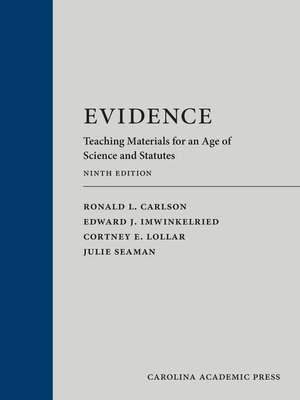Evidence
ebook ∣ Teaching Materials for an Age of Science and Statutes (with Federal Rules of Evidence Appendix)
By Ronald L. Carlson

Sign up to save your library
With an OverDrive account, you can save your favorite libraries for at-a-glance information about availability. Find out more about OverDrive accounts.
Find this title in Libby, the library reading app by OverDrive.



Search for a digital library with this title
Title found at these libraries:
| Library Name | Distance |
|---|---|
| Loading... |
This coursebook employs a state-of-the-art approach to the problem method of teaching Evidence. The beginning of the text sets out two case files, one civil and one criminal. All of the problems in the text are based on those files. The student does not waste time learning a new fact situation to analyze every problem, and the use of the case files throughout the course simulates the real-world experience of gaining increasingly sophisticated insights into a fact pattern as the student works with the files for months.
One emphasis of the text is statutory construction, since this is the Age of Statutes. Chapter Two includes an excerpt from an article by two leading legisprudence scholars, Professors Eskridge and Frickey, and introduces the ongoing debate over the proper approach to the construction of the Federal Rules of Evidence. In the following chapters, the coursebook repeatedly calls on the student to carefully parse text, consider context, and assess the weight of extrinsic legislative materials. As a takeaway from the course, the student should have an enhanced understanding of the importance of statutory construction and increased interpretive skill.
A second emphasis is the use of empirical data to assess expert methodologies and the underlying psychological assumptions of evidentiary doctrines. One estimate is that today, in an average trial in a court of general jurisdiction, four experts take the witness stand. Chapter One includes an excerpt from the classic text, Inside the Jury, discussing the analysis of empirical data. Chapter Twelve includes a list of considerations that courts should weigh in evaluating a data set. As another takeaway from the course, the student should have a greater comfort level working with empirical data under Daubert and, more broadly, in using data to critique evidentiary doctrines.







